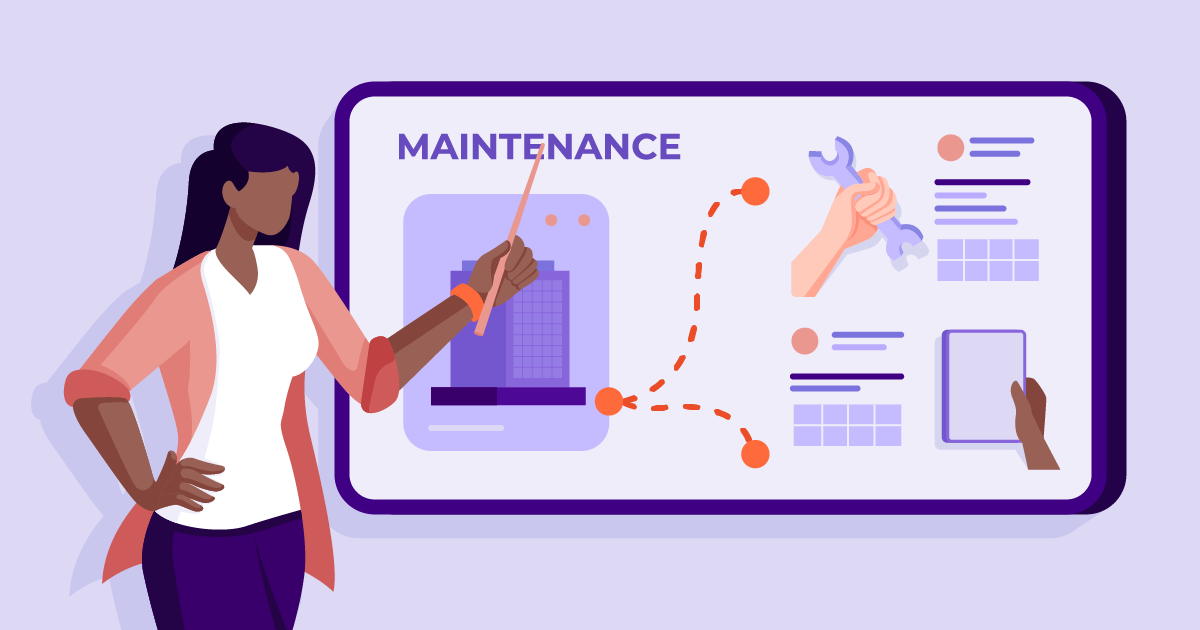Ductwork Maintenance: Ensuring Efficiency and Longevity of HVAC Systems

We’re here to shed some light on the often overlooked, yet incredibly important aspect of HVAC systems—the maintenance of your ductwork. When it comes to keeping your home comfortable and your air quality pristine, ensuring the efficiency and longevity of your ductwork is paramount.
Now, you might be wondering, why is ductwork maintenance so crucial? Well, that’s exactly what we’re here to discuss. In this blog post, we’ll delve into the nitty-gritty details of ductwork maintenance, covering everything from understanding the components of your ductwork system to the impact of neglecting maintenance tasks. We’ll provide you with a comprehensive guide on essential checks, preventive and predictive maintenance, cleaning and sealing, routine inspections, preparing for unexpected setbacks, and even introduce you to a cutting-edge solution called FieldInsight that can revolutionize the way you manage your ductwork maintenance.
By the end of this blog post, you’ll have a solid understanding of why maintaining your ductwork is so crucial, what tasks you need to prioritize, and how to leverage the right tools to simplify the process. So, whether you’re a homeowner looking to optimize your HVAC system’s performance or an commercial HVAC professional seeking insights into effective maintenance strategies, this blog post is for you.
Let’s embark on this journey together and discover the key steps to ensure the efficiency and longevity of your ductwork system. So, without further ado, let’s get started and dive into the world of ductwork maintenance!
Understanding Your Ductwork System
When it comes to the intricate workings of your HVAC system, understanding the key components of your ductwork is essential. Let’s take a closer look at these components and their roles in the overall operation and efficiency of your system.
First up, we have the ducts. These are the pathways through which conditioned air flows from your HVAC unit to different rooms in your home. The ducts can be made of various materials, such as sheet metal, fiberglass, or flexible plastic. Regular maintenance of ducts involves inspecting them for leaks, ensuring proper insulation, and keeping them clean from debris, dust, and allergens.
Next, we have the vents and registers. These are the openings in your walls, floors, or ceilings where air is released into your living spaces. Vents and registers play a crucial role in maintaining proper airflow and temperature distribution throughout your home. It’s important to regularly clean and inspect them, ensuring they are not obstructed by furniture, dust, or any other obstructions that might hinder the airflow.
Filters are another vital component of your ductwork system. They are responsible for capturing dust, pollen, and other airborne particles, preventing them from circulating through your home. Filters should be regularly cleaned or replaced to ensure they don’t become clogged, which can reduce airflow and strain your HVAC system.
All of these components work in harmony to deliver comfortable temperatures and clean air throughout your home. However, without regular maintenance, problems can arise. Leaky ducts can result in energy waste and reduced efficiency, leading to higher energy bills. Clogged filters can restrict airflow and put a strain on your HVAC system, potentially causing breakdowns or reduced performance.
By conducting routine maintenance on these key components of your ductwork system, you can ensure that air flows smoothly, energy is efficiently distributed, and your indoor air quality remains at its best. Regular inspections, cleaning, and repairs are crucial to keep your system running smoothly and extend its lifespan.
So, as you can see, understanding and maintaining these essential components of your ductwork system is vital for the efficient and long-lasting operation of your HVAC system. Let’s move forward and explore the importance of regular maintenance in more detail.
The Importance of Regular Ductwork Maintenance
Consistent maintenance is the key to the efficient operation and longevity of your ductwork system. Neglecting maintenance can lead to a range of problems, such as decreased energy efficiency and compromised indoor air quality. By taking proactive steps to care for your ductwork, you can avoid these issues and ensure a comfortable and healthy living environment.
Essential Checks for Ductwork Systems (Air Duct Cleaning)
When it comes to asset management and maintaining your ductwork system, there are several key maintenance tasks that should be performed regularly to ensure optimal performance and efficiency. Let’s delve deeper into these essential checks for air ducts and understand why they are crucial.
First and foremost, checking for leaks in your ductwork is vital. Leaky air ducts can result in significant energy waste and reduced efficiency. Air leaks in your duct system can occur due to loose connections, damaged seals, or deteriorated ductwork. By inspecting your ducts for any signs of leaks, such as visible gaps or feeling for air escaping, you can address these issues promptly. Sealing the leaks using appropriate duct sealants or contacting a professional for repairs will help maximize energy efficiency and minimize heat or cool air loss.
Dust and debris accumulation within your ductwork can impede proper airflow and strain your HVAC system. Over time, particles like dust, pet dander, and allergens can settle within the ducts, restricting airflow and reducing system performance. Regularly inspecting and cleaning your ducts can help remove these contaminants, ensuring that air can flow freely and maintaining optimal efficiency. Consider hiring professionals who specialize in duct cleaning or using specialized tools designed to effectively clean the interior of your ductwork.
Mould growth is another issue that warrants attention. Damp or humid conditions within your ductwork can create an environment conducive to mould growth. Mould not only affects the performance of your HVAC system but can also have adverse effects on indoor air quality, potentially leading to respiratory issues or allergies. Regularly inspecting your ducts for any signs of mould, such as a musty odour or visible patches, is crucial. If mould is detected, it’s essential to address the underlying moisture issue and seek professional assistance for proper remediation.
Furthermore, pay attention to wear and tear on seals and joints within your air ductwork. Over time, seals and joints may become worn or damaged, leading to air leakage and decreased efficiency. Inspecting these areas for any signs of deterioration or gaps and promptly repairing or replacing damaged components will help maintain the integrity of your ductwork system.
By regularly performing these essential maintenance tasks, you can identify and address potential issues before they escalate, ensuring that your ductwork system operates efficiently and effectively. Remember, proactive maintenance not only helps improve energy efficiency but also contributes to better indoor air quality and extends the lifespan of your HVAC system.
Now that we understand the importance of regular maintenance for your air duct system, let’s explore the difference between preventive and predictive maintenance approaches and their role in maximizing the efficiency and longevity of your ductwork system.
The Role of Preventive and Predictive Maintenance in Ductwork Systems
When it comes to job management and maintaining the efficiency and longevity of your ductwork system, two approaches play a vital role: preventive maintenance and predictive maintenance.
Preventive maintenance is all about staying ahead of potential issues before they even arise. It involves proactive measures to prevent breakdowns and optimize the performance of your ductwork system. Regular inspections of your ducts, vents, registers, filters, and other components allow you to identify any signs of wear, damage, or potential problems. By addressing these issues promptly, you can prevent them from escalating into larger, more costly repairs. Additionally, scheduling regular cleaning and tune-ups as part of your preventive maintenance routine ensures that your ductwork system remains clean, free from debris, and operates at its peak efficiency.
On the other hand, predictive maintenance takes advantage of advanced technology to monitor the performance of your ductwork system in real time. This approach involves the use of sensors, monitoring devices, and data analytics to track various parameters such as airflow, temperature differentials, and energy consumption. By continuously monitoring these factors, any deviations or anomalies can be detected early on, allowing for timely intervention and preventive measures. Predictive maintenance helps identify potential issues before they cause significant problems, enabling you to schedule repairs or replacements at a convenient time and avoid unexpected breakdowns.
By combining both preventive and predictive maintenance approaches, you can maximize the efficiency and longevity of your ductwork system. Preventive maintenance ensures that regular inspections, regular cleanings, and tune-ups are performed to keep your system in optimal condition. This proactive approach helps identify and address minor issues before they become major problems. On the other hand, predictive maintenance harnesses technology to monitor and analyze system performance, providing insights into potential issues and allowing for proactive intervention.
By implementing both approaches, you can enjoy several benefits. Firstly, you can significantly extend the lifespan of your ductwork system, as regular maintenance prevents premature wear and damage. Secondly, you minimize unexpected breakdowns and the associated costs and inconveniences. Thirdly, by maintaining the efficiency of your ductwork system, you can optimize energy consumption, leading to potential energy savings.
In summary, combining preventive maintenance, with its focus on regular inspections, cleanings, and tune-ups, and predictive maintenance, utilizing advanced technology for real-time monitoring, offers a comprehensive approach to ductwork maintenance. By implementing both approaches, you can ensure the efficiency, longevity, and reliability of your ductwork system, providing comfort and clean air to your home while minimizing unexpected surprises along the way. Ensure that you’re not dealing with duct leaks, issues with your cooling coils, or dirty air ducts, stay on top of your duct cleaning.
The Significance of Regular Cleaning and Sealing
Regular cleaning and sealing are vital aspects of ductwork maintenance. Cleaning helps remove dust, allergens, and other contaminants, promoting better indoor air quality. Sealing any leaks or gaps in your ductwork prevents air leakage, optimizing energy efficiency.
Creating checklists is vital to ensure that your air duct cleaning is thorough and to maintain. This can include steps such as:
- Pre-inspection: Perform a thorough inspection of the air duct system to assess its condition and identify any potential issues.
- Equipment Preparation: Gather the necessary equipment for the cleaning process, including high-powered vacuums, brushes, and disinfectants.
- Protect Surfaces: Take measures to protect surrounding surfaces, such as floors, walls, and furniture, to prevent any damage or contamination during the cleaning process.
- Remove Vent Covers: Carefully remove vent covers, registers, and grilles to gain access to the ductwork.
- Vacuum Cleaning: Use high-powered vacuums with HEPA filters to remove household dust, dirt, and debris from the air ducts. Pay special attention to hard-to-reach areas and corners.
- Brush Cleaning: Utilize specialized brushes and agitators to dislodge and remove any stubborn debris or buildup inside the ducts. This helps ensure a thorough cleaning.
- Disinfection: Apply appropriate disinfectants or antimicrobial solutions to eliminate any microbial growth, such as mold or bacteria, within the air ducts.
- Filter Replacement: Check and replace air filters if necessary, ensuring clean and efficient airflow throughout the system.
- Vent Covers Replacement: Once the cleaning is complete, reattach the vent covers, registers, and grilles securely.
- Final Inspection: Conduct a final inspection to ensure that all cleaning tasks have been completed successfully and the air duct system is in proper working condition.
- Documentation and Recommendations: Provide a detailed report of the cleaning process, including any observations, recommendations, or potential issues discovered during the maintenance. Offer advice on future maintenance and filter replacement schedules as a duct cleaning service provider.
Remember, this checklist serves as a general guideline. HVAC professionals may need to tailor it to specific requirements based on the condition of the air ducts and any additional services requested by the client. By following a comprehensive checklist like this, HVAC professionals can ensure a thorough and efficient cleaning and maintenance process for air ducts.
The Importance of Routine Inspections and Health Check-ups
Routine inspections and health check-ups are essential for maintaining the efficiency of your ductwork system. Schedule professional inspections to identify any underlying issues, such as leaks or airflow restrictions. Regular check-ups ensure that your system operates at its best, saving you from potential problems down the road.
Preparing for Unexpected Setbacks: The Role of Spare Components and Emergency Repairs
When it comes to ductwork preventive maintenance, being prepared for unexpected setbacks is a crucial aspect of ensuring the efficient operation of your system. By taking proactive steps and having a plan in place, you can minimize downtime and swiftly address any issues that may arise. Let’s delve deeper into the importance of preparedness and the steps you can take.
One key aspect of preparedness is keeping spare components on standby. Despite regular maintenance, there’s always a chance that a part in your ductwork system may malfunction or break unexpectedly. By having spare components readily available, you can quickly replace faulty parts and minimize any disruptions to your system’s operation. It’s advisable to work with an HVAC professional to identify the critical components that may require replacements and ensure you have them on hand when needed.
Establishing procedures for emergency repairs is another essential element of preparedness. This involves having a clear plan of action in case of a breakdown or malfunction. Maintain a list of reliable HVAC technicians or contractors who specialize in ductwork repairs and make sure their contact information is easily accessible. In an emergency situation, you can promptly reach out to these professionals for assistance, ensuring that repairs are handled efficiently and effectively.
By being proactive in handling unforeseen circumstances, you can minimize downtime and ensure your ductwork system gets back up and running smoothly. Promptly addressing issues and performing necessary repairs or replacements prevents further damage or complications that could arise from a prolonged system downtime. This not only helps maintain the comfort of your living spaces but also prevents potential secondary issues, such as increased energy consumption or compromised indoor air quality.
Being prepared for unexpected setbacks not only saves you time and money but also provides peace of mind. You can rest assured knowing that you have a plan in place and the necessary resources available to handle any unforeseen issues that may arise with your ductwork system. By taking a proactive approach, you can swiftly address problems, minimize disruptions, and ensure the efficient operation of your HVAC system.
In conclusion, maintaining spare components and establishing procedures for emergency repairs are essential steps in ductwork maintenance. By being prepared, you can minimize system downtime, swiftly address unexpected setbacks, and ensure your ductwork system operates efficiently and reliably. So, make sure you’re ready for the unexpected by keeping spare parts on standby and having reliable HVAC professionals on speed dial. Now, let’s move on and explore how a cutting-edge solution called FieldInsight can enhance your ductwork maintenance practices.
Leveraging FieldInsight for Ductwork Maintenance
When it comes to managing ductwork maintenance, staying organized and efficient is crucial. That’s where FieldInsight comes into the picture. This comprehensive solution offers a range of features designed to simplify the scheduling and tracking of your ductwork maintenance tasks, making the entire process a breeze.
One of the key advantages of FieldInsight is its ability to streamline the scheduling of maintenance tasks. With this software, you can easily create and manage maintenance schedules for your ductwork system. This proactive approach helps prevent issues and keeps your system operating at its best.
FieldInsight also provides powerful tracking capabilities. By utilizing this solution, you can easily keep track of all maintenance tasks performed on your ductwork system. Real-time updates and alerts ensure that you never miss a maintenance appointment or inspection. FieldInsight keeps you informed about upcoming tasks and sends timely reminders, helping you stay on top of your ductwork’s health.
Key Takeaways for Your Heating and Cooling System
To wrap it up, proper maintenance is vital for ensuring the efficiency and longevity of your ductwork system. Understanding the key components, performing essential checks, and investing in preventive and predictive maintenance are essential steps. Regular cleaning, sealing, inspections, and preparedness for unexpected setbacks all contribute to a well-maintained ductwork system. Don’t forget to explore FieldInsight as a comprehensive solution for your ductwork maintenance needs.
Now, go ahead and take the next step by exploring FieldInsight and experience the benefits of efficient ductwork maintenance firsthand. Your HVAC system will thank you!
What You Should Do Now
- Book a Demo. You’ll be in touch with an automation expert who has worked in this space for over 5 years, and knows the optimal workflow to address your needs.
- If you’d like access to free articles about managing HVAC workflows, go to our blog.
- If you know someone who’d enjoy reading this page, share it with them via email, Linkedin, Twitter, or Facebook.




